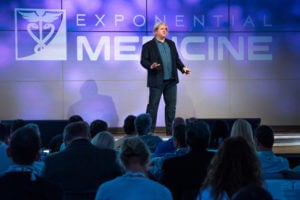3 DNA Technologies That Will Forever Change Your Home Life

Share
You’ve likely heard that the DNA revolution is here, but we’ve yet to see it manifest in our daily lives and homes.
Speaking at this year’s Exponential Medicine conference, Raymond McCauley talked about how our expanded abilities to read, write and hack DNA are opening up entirely new possibilities.
Here are three innovations in DNA technologies that could transform our home lives in the near future:
1. Networked household objects that track and report on health

Sequencing the first human genome was a Herculean task that took over a decade to complete at a cost of nearly 3 billion U.S. dollars. Today, anyone can have their entire genome sequenced in 12 hours for $1000, and companies are racing towards a future where sequencing a complete human genome costs just $100.
McCauley predicts that in 2018, the cost of sequencing a human genome will be under $20, or the cost of a delivery pizza. By 2022, it’ll be the same cost as flushing a toilet. More than that, he imagines we’ll likely have gene sequencers inside toilets.
In fact, McCauley believes that toilets will be the most networked appliance in the home of the future. One day, not only will toilets sense how healthy our bodies and diets are, they’ll provide tips, such as, “You’ve really got to stop eating chorizo.”
Currently, the limiting factor for DNA reading to become more commercialized is developing the right software to interpret all the data, so that we can gain meaningful insights from the long lines of As, Ts, Cs, and Gs.
2. Cellular agriculture that generates animal products without the animals
McCauley sees huge potential in “cellular agriculture,” as in making eggs without chickens and beef without cows. We will soon see a day when our favorite animal products will be animal free.
As I’ve written about before, scientists have discovered animals are conscious in similar ways to humans. Yet the habit of eating animals and using their bodies as commodities is likely not going to disappear soon.
Be Part of the Future
Sign up to receive top stories about groundbreaking technologies and visionary thinkers from SingularityHub.


However, new companies are providing means to move away from these practices by creating materials, foods and products in the lab that don’t harm animals in the process. For example:
- Memphis Meats grows beef, pork and poultry tissue in the lab by feeding animal stem cells a mixture of oxygen, sugar and minerals, which over several weeks develop into skeletal muscle in a bioreactor.
- MycoWorks grows a new kind of leather from mycelium (mushrooms), and other byproducts in a “carbon-negative process.”
- New Wave Foods creates a shrimp (the most consumed seafood in the U.S.) substitute grown from plant proteins and algae.
- Geltor uses microbes to produce an animal-free gelatin for use in foods, cosmetics and medicines.
3. Affordable household bio-labs that generate bacteria to produce everything from perfumes to medicines
Animo Labs is a tabletop mini-lab that allows kids (and adults) to quickly and easily start engineering biology. It can grow bacteria that adopts various colors or glows in the dark.
But the team has a bigger vision for their “bento box” lab. Julie Legault, CEO of Animo Labs, told me, “Our goal for the long term it to create a distributed process for bio-production. If you can manufacture in the same way that large companies do today, but in smaller quantities, you can make anything from personalized perfume to insulin in the home.”
Today, we can now read, write and hack DNA with an ease and precision that’s never been possible before. As the cost of using these new tools continues to fall, we'll see more products and innovative startups push the limits of what's possible with DNA.
Want to keep up with coverage from Exponential Medicine? Get the latest insights here.
Image credit: Shutterstock
Sveta writes about the intersection of biology and technology (and occasionally other things). She also enjoys long walks on the beach, being underwater and climbing rocks. You can follow her @svm118.
Related Articles

New Gene Drive Stops the Spread of Malaria—Without Killing Any Mosquitoes

New Immune Treatment May Suppress HIV—No Daily Pills Required

Scientists Just Developed a Lasting Vaccine to Prevent Deadly Allergic Reactions
What we’re reading